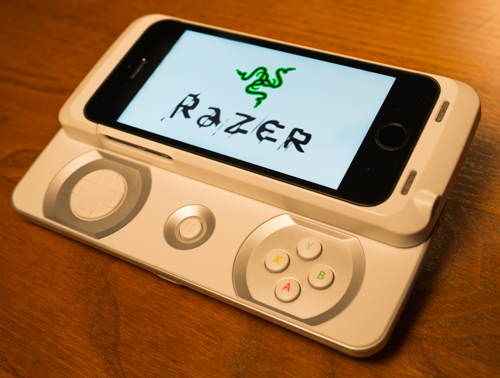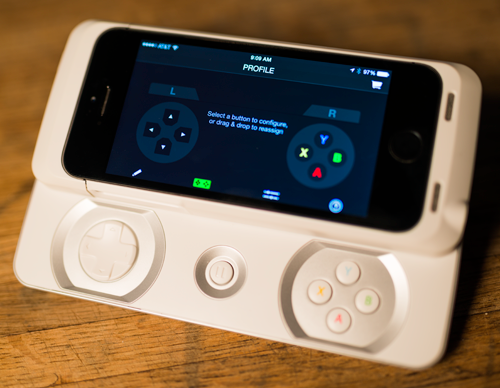Exclusive: Hands-on Razer Junglecat MFi Controller Preview
Ever since its big reveal last month, the Razer Junglecat has vaulted to the top of the list of upcoming MFi controllers I’ve been most excited about. While many people have been eagerly awaiting a full-size Xbox / PlayStation style bluetooth controller, to me, the idea of the Junglecat is almost more intriguing â a controller designed to stay on your iPhone all the time, occupying a minimum of space, and turning a regular iPhone into a true mobile game console.

Over the past week or so, I’ve been using a preview copy of the Junglecat controller that Razer was nice enough to send me. I’ll be posting a full review once the final version is available, but I’ve managed to get some impressions from using this pre-release version.
Read on to learn quite a bit more about what gaming on the Junglecat is like.
The Controller
In their quest to make the smallest and most portable iPhone controller design possible, Razer opted for a sliding mechanism, where the controls themselves are on a lower section that slides smoothly under the iPhone when not in use. It is a design explored very similarly by Sony for their PSPGo console several years ago, though the Razer controller feels far superior to Sony’s offering, both in build quality and in playability.
Despite the sliding mechanism having such a strong resemblance to the PSPGo, the white Junglecat I’ve been sampling actually reminds me of the Nintendo DS; not just in color and layout, but in the feel and spacing of the buttons and d-pad. The size is almost identical to some of Nintendo’s handhelds as well; anyone who could comfortably fit a DS or a 3DS in their pocket will have no problems at all carrying the Junglecat.

D-pads have been a weakness of every MFi controller released so far. The d-pads on the previously released controllers all require too much pressure to activate, and many of them are badly textured or too large. With that said, the d-pad on the Junglecat feels about as good as you’re going to get with the circular design that Apple mandates for MFi controller manufacturers. It’s still circular, but its small enough to easily cover the entire range of motion. It still requires a little too much pressure to activate, but it does require less than the other available controllers. I was also told by Razer that the pressure sensitivity of the buttons and d-pad is not quite finalized, so hopefully this can be improved before the final version enters mass production. In addition to the d-pad, the buttons themselves are solidly built. They feature a matte finish, they press down with a perfect amount of depth, and they’re spaced a nice distance apart from one another for a mobile device.
Perhaps the most important aspect of the build quality of the Junglecat is the sliding mechanism. This sliding piece is going to be beat up and used constantly, and yet still has to be strong enough to hold the controller closed when not in use. I’m happy to say that Razer seems to have absolutely nailed this. The Junglecat feels sturdy, smooth, and overall pleasant when sliding out and retracting. The aluminum backing feels sturdy, and the mechanism slides out without a hint of roughness. Time will tell how strong the design turns out to be, but it certainly feels solid for now, and there hasn’t been the slightest hint of wear over the past few weeks of heavy use.

Attaching the iPhone to the Junglecat is straightforward: the left side of the iPhone case part of the controller detaches, allowing the iPhone to slide in and dock with the Lightning adapter on the right side. Once the iPhone is in place, the case re-attaches securely. The connection feels snug and stable, and at no point have I felt like the iPhone is in danger of coming out. In fact, removing the iPhone is somewhat difficult, and requires almost pushing it out by the screen itself. This is not a case designed to come off â Razer is aiming for a product you leave on your iPhone all the time.
In fact, that is the main point of the Junglecat: portability. Being small enough to carry with you anywhere, all the time, without the discomfort of a big controller case. In the time I’ve spent with the Junglecat, it has stayed on my iPhone consistently, and I haven’t found any issues with size or bulkiness.
The Games
The Junglecat is an official MFi controller using the Standard layout specification â 4 face buttons, a circular d-pad, a pause button, and two shoulder buttons. This is opposed to the Extended layout, which adds two analog sticks and two triggers. Razer’s decision to use only the Standard layout design is a little unfortunate for those hoping to get the best experience from shooter games, but it was likely done in order to slim the size of the case down. Ultimately, there are hundreds of games currently available that are compatible with the Standard layout, so even without the analog sticks, gamers should have no problem finding something to play.

As for the actual experience of playing games with the Junglecat, my impressions so far are very positive. I’ve thrown some really difficult games at it – twitch reaction platformers, fighting games, high-speed racers, even one of my most demanding test games: Tony Hawk’s Pro Skater. All of them were fully playable and enjoyable, and I had no issues hitting combos with the buttons or timing things accurately. I will continue to test a wide selection of games, and will expand on this for the final Junglecat review.
The Visual Design
I want to spend a little time talking about that visual design, because I think it’s particularly commendable, and speaks volumes about how seriously Razer has taken this market.
To put it simply, the design is clean. This may not sound like a big deal, but it’s extremely unusual for Razer â a company with an aggressive and opinionated design language. Razer products are defined by neon green lighting, sharp angled surfaces, dark black plastic with vivid highlights, backlit logos; Razer makes hardcore gaming products with a design language that screams “hardcore gamer”. The gamers who purchase Razer products are doing so partly because they want to be part of design experience Razer provides. It’s a loyal fan-base, and it takes the neon Razer logos and backlit mechanical keyboards as marks of pride.
This Junglecat controller couldn’t be more different from Razer’s usual designs. Short of a simple Razer logo embossed in the plastic on the rear of the controller, nothing about this controller screams out that it’s anything other than an Apple product. And I think that shows enormous understanding of the market. Because just as Razer’s hardcore PC gaming customers embrace Razer’s visual identity, Apple’s equally-loyal customers embrace Apple’s visual identity. Apple’s design is a huge part of the reason people buy Apple products. The Junglecat doesn’t try to sell you part of the Razer ecosystem, with the identity that entails; it’s simply about making a nice controller for your iPhone, and then getting out of the way and letting you play. To me, this shows Razer is serious about the iOS market. They’re not playing to their fan base, but instead trying to make the best controller possible for everyone â even those who’ve never heard of Razer before.

This understated design is particularly noteworthy because it is something Razer’s competitors have dropped the ball on. The other controller makers all opted to put brightly colored plastic, neon lights, or chrome nameplates on their controllers, to make it clear to anyone using it that it isn’t an Apple gaming experience, but rather an insert-brand-here experience â a decision that I think happens to be out-of-touch with what Apple customers want out of a product.
The App
The most interesting aspect of the Junglecat actually isn’t part of the controller at all, but rather is something that comes with it. Razer will be shipping the Junglecat with a companion app. This app will serve as a place to find compatible games for the controller, and more importantly, to customize aspects of the controller to your tastes. Every button can be rearranged and reassigned, which allows you to compensate for bad button mapping decisions made by certain game developers.

Perhaps most importantly, the sensitivity of the d-pad and buttons is completely customizable. This allows the user to choose between fine-grained pressure sensitivity detail or fast-acting high-sensitivity buttons. Whats more, these settings can be saved to multiple profiles. For games without pressure sensitivity, turning off fine-grain pressure controller will allow for far faster action. For platforming games where movement speed is critical, a d-pad with the biggest range of motion might be ideal.
These customization options might not seem like a big deal, but in practice, they really improve the experience of actually playing games. Razer really hit it out of the park with this feature.

Final Impressions
I went in to the experience of using the Junglecat excited about the prospect of having a controller that was light enough and portable enough to remain attached to the iPhone full time. After using it for a decent length of time, I’m convinced that Razer might seriously be on to something here. This is the first available MFi controller that I think could have a real mass market appeal for a lot of iPhone users. The built quality is solid, the design is highly portable, and the aesthetics are unobtrusively clean.
The big question mark to me is the price. Razer announced the Junglecat with a $99 price point, and I’m not sure that’s something that a mass-market audience will be able to stomach. There is no doubt that the Junglecat is a quality product, but that is not a cheap price to pay, even for quality. With that said, there is still time before to adjust the price before release â in fact, Amazon is already listing the pre-order cost as $88, which is heading the right direction. And if Apple is as committed to showing off these controllers as we all hope they will be, the Junglecat should have no problem selling.
Cost aside, there is no doubt that the Junglecat is a quality product. I’ll put together a more thorough review and comparison between controllers when the Junglecat is finalized and available for sale, but it’s already clear to me that this has the potential to be a real winner. For gamers who are looking for an always-ready, always-connected controller for their iPhone, it’s going to be very hard to beat the Junglecat.
For more information about the Junglecat, visit Razer, or check out the complete list of compatible games for the Junglecat.